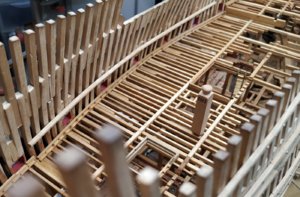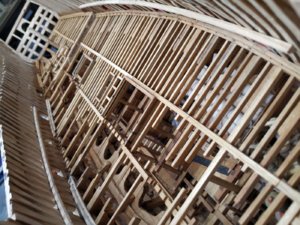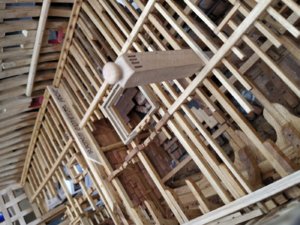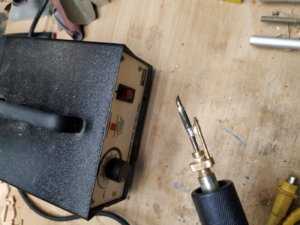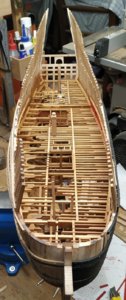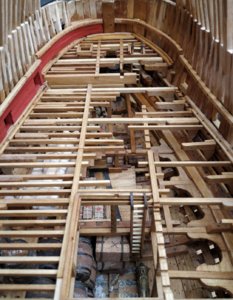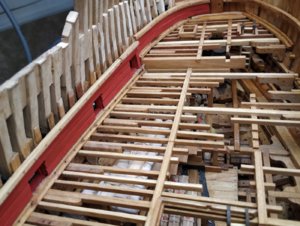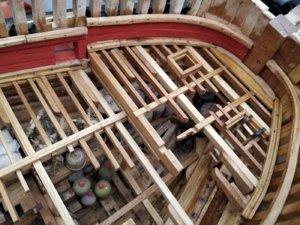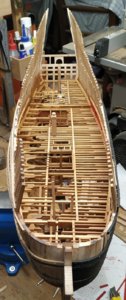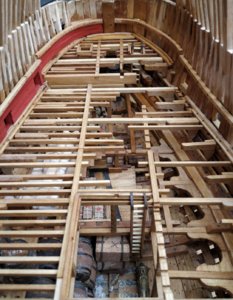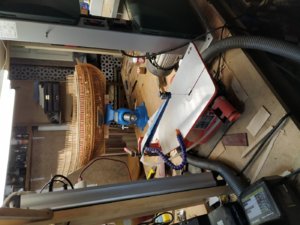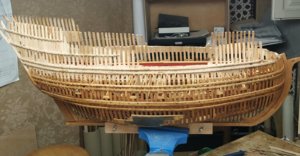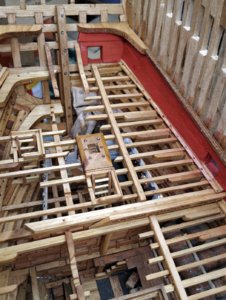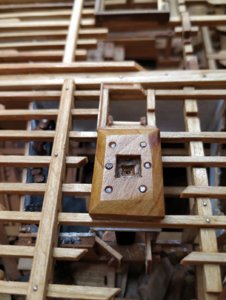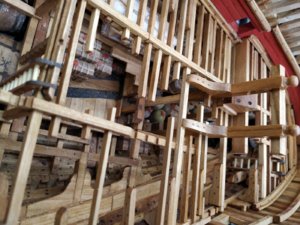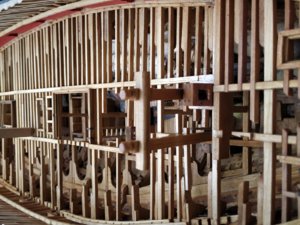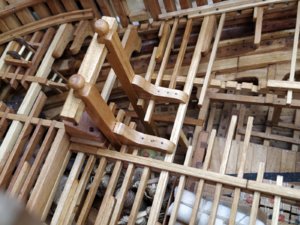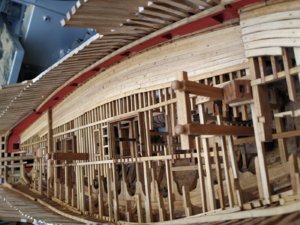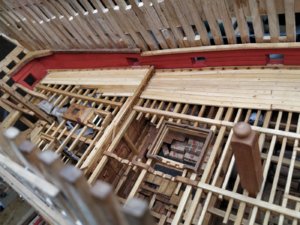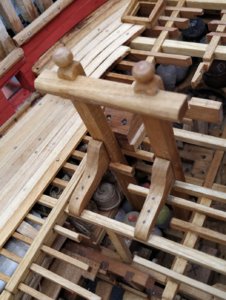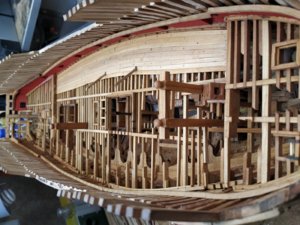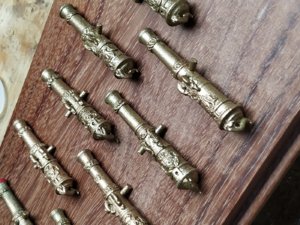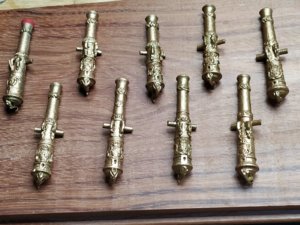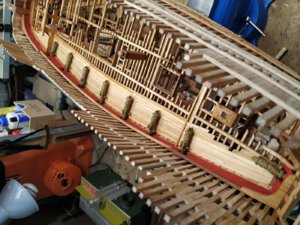You are using an out of date browser. It may not display this or other websites correctly.
You should upgrade or use an alternative browser.
You should upgrade or use an alternative browser.
SPANISH GALLEON XVII. GALEON DEL AZOGUE [COMPLETED BUILD]
- Thread starter ramonolivenza
- Start date
- Watchers 62
-
- Tags
- completed build
- Joined
- Aug 16, 2019
- Messages
- 870
- Points
- 343

Always amazed by the precision and the attention to detail to build a scratch model 

- Joined
- Aug 16, 2019
- Messages
- 870
- Points
- 343

Way over my skill
A pleasure to follow
A pleasure to follow
One side is closed, the other is very light and unlined to see the interior and construction detailsGood progress, I wonder if you want to open the hull on one side to show all the nice details you made inside the hull? thanks.
These guns are looking very good - and I guess they were specially produced for this model.
Please be so kind to tell us, how they were made, By yourself, or do you have a supplier for this?
Would be very interesting, due to the fact, that supply of the correct muzzles are often a problem
Please be so kind to tell us, how they were made, By yourself, or do you have a supplier for this?
Would be very interesting, due to the fact, that supply of the correct muzzles are often a problem
Los cañones, los hago yo. Están hechos conforme a las medidas e indicaciones del Tratado de "Platica Manual y Breve Compendio de Artillería" de Firrufino (año 1626). Son cañones de 24 y 12 libras, de bronce y decorados conforme a la época con el escudo del rey Felipe IV de España.These guns are looking very good - and I guess they were specially produced for this model.
Please be so kind to tell us, how they were made, By yourself, or do you have a supplier for this?
Would be very interesting, due to the fact, that supply of the correct muzzles are often a problem
Están hechos con una técnica mixta: Madera torneada y la decoración añadida, esculpida en arcilla polimérica horneada. Posteriormente llevan un tratamiento de imprimación, pintura y polvo de bronce. Estan hechos uno a uno, no utilizo molde ni producción en serie (cast)
The cannons, I make them. They are made in accordance with the measures and indications of the "Manual and Brief Artillery Compendium" Treaty of Firrufino (year 1626). They are guns of 24 and 12 pounds, bronze and decorated according to the time with the shield of King Felipe IV of Spain.
They are made with a mixed technique: Turned wood and added decoration, sculpted in baked polymer clay. Subsequently they carry a treatment of primer, paint and bronze powder. They are made one by one, I do not use mold or series production (cast)
- Joined
- Aug 16, 2019
- Messages
- 870
- Points
- 343

Making your gun
Ok that is craftsmanship
WOW
Ok that is craftsmanship

WOW
Hi Ramon,Los cañones, los hago yo. Están hechos conforme a las medidas e indicaciones del Tratado de "Platica Manual y Breve Compendio de Artillería" de Firrufino (año 1626). Son cañones de 24 y 12 libras, de bronce y decorados conforme a la época con el escudo del rey Felipe IV de España.
Están hechos con una técnica mixta: Madera torneada y la decoración añadida, esculpida en arcilla polimérica horneada. Posteriormente llevan un tratamiento de imprimación, pintura y polvo de bronce. Estan hechos uno a uno, no utilizo molde ni producción en serie (cast)
The cannons, I make them. They are made in accordance with the measures and indications of the "Manual and Brief Artillery Compendium" Treaty of Firrufino (year 1626). They are guns of 24 and 12 pounds, bronze and decorated according to the time with the shield of King Felipe IV of Spain.
They are made with a mixed technique: Turned wood and added decoration, sculpted in baked polymer clay. Subsequently they carry a treatment of primer, paint and bronze powder. They are made one by one, I do not use mold or series production (cast)
That is definately worth a special topic on how you make these exactly. This as the result is spectaculair. Especially the bronze powder treatment I am interested in.
I am second what Maarten said. I would love to learn the way you made your artillery. I think it looks really realistic.Hi Ramon,
That is definately worth a special topic on how you make these exactly. This as the result is spectaculair. Especially the bronze powder treatment I am interested in.
I agree and underline the kind request of our friends -> It would be highly interested to see your work on the cannons and their production
El método de hacer los cañones, es el siguiete:
1 Se hace el cañón en madera. torneado, esto no tiene misterio.
2 A continuación comiienza la decoración. La dercoración la hago con arcilla polimerica. Hay muchas marcas la mas conocida es FIMO, pero hay muchas. Esta arcilla se endurece mediante cocción en horno.
3 Primero pego en el cañon una porción de arcilla. Se pega facil y solidamente con cola blanca.
4 Despues tallo el dibujo, con buriles, microformones etc... Aquí no hay atajos.
5 Una vez que tengo la decoración esculpida, horneo el cañon, 120º, unos 15 minutos. Así la arcilla fragua y se endurece.
6 Cuando se trata de piezas complicadas lo mejor es hacerlo por partes (y hornear varias veces)
7 Una vez fria la pieza, se da una capa de imprimación. Despues, se pinta con una mezcla de pintura de bronce y verde. El último paso es aplicar polvo de bronce con un pincel de maquillar antes de que la pintura haya secado del todo.
The method of making the cannons is the following:
1 The cannon is made of wood. on the lathe, this has no mystery.
2 Next the decoration begins. I make the decoration with polymer clay. There are many brands the best known is FIMO, but there are many. This clay is hardened by baking.
3 First I hit a piece of clay in the barrel. It sticks easily and solidly with white glue.
4 Then I sculpt the decoration, with gouges, chisels etc ... There are no shortcuts here.
5 Once I have the sculpted decoration, I bake the cannon, 120º, about 15 minutes. Thus the clay sets and hardens.
6 When it comes to complicated parts it is best to do it in parts (and bake several times)
7 Once the piece has cooled, a coat of primer is given. Then, it is painted with a mixture of bronze and green paint. The last step is to apply bronze powder with a make-up brush before the paint has dried completely.
1 Se hace el cañón en madera. torneado, esto no tiene misterio.
2 A continuación comiienza la decoración. La dercoración la hago con arcilla polimerica. Hay muchas marcas la mas conocida es FIMO, pero hay muchas. Esta arcilla se endurece mediante cocción en horno.
3 Primero pego en el cañon una porción de arcilla. Se pega facil y solidamente con cola blanca.
4 Despues tallo el dibujo, con buriles, microformones etc... Aquí no hay atajos.
5 Una vez que tengo la decoración esculpida, horneo el cañon, 120º, unos 15 minutos. Así la arcilla fragua y se endurece.
6 Cuando se trata de piezas complicadas lo mejor es hacerlo por partes (y hornear varias veces)
7 Una vez fria la pieza, se da una capa de imprimación. Despues, se pinta con una mezcla de pintura de bronce y verde. El último paso es aplicar polvo de bronce con un pincel de maquillar antes de que la pintura haya secado del todo.
The method of making the cannons is the following:
1 The cannon is made of wood. on the lathe, this has no mystery.
2 Next the decoration begins. I make the decoration with polymer clay. There are many brands the best known is FIMO, but there are many. This clay is hardened by baking.
3 First I hit a piece of clay in the barrel. It sticks easily and solidly with white glue.
4 Then I sculpt the decoration, with gouges, chisels etc ... There are no shortcuts here.
5 Once I have the sculpted decoration, I bake the cannon, 120º, about 15 minutes. Thus the clay sets and hardens.
6 When it comes to complicated parts it is best to do it in parts (and bake several times)
7 Once the piece has cooled, a coat of primer is given. Then, it is painted with a mixture of bronze and green paint. The last step is to apply bronze powder with a make-up brush before the paint has dried completely.
Very interesting and promissing te technique with marvelous results. This as in a lot of cases the guns on a war ship were mostly all different pieces which slightly differ from each other and that can be realized better with this then by casting.

